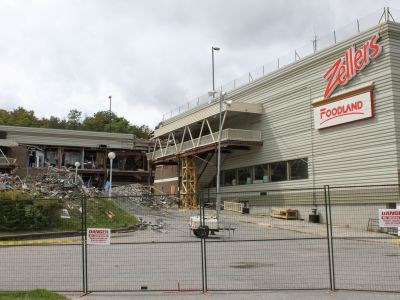A new report indicates multiple, persistent problems contributed to the collapse of the Algo Centre Mall’s roof in Elliot Lake last June, but ultimately it was the corrosion of a steel beam due to water leakage that brought a portion of the concrete structure crashing down two storeys.
The report, entitled Forensic Engineering Investigation: Algo Centre Mall Collapse, is a result of an investigation conducted by engineering and architectural firm NORR in July 2012 following the roof collapse, which killed two women and injured 20 more.
An excerpt of the report, commissioned as part of the ensuing OPP investigation, was released to the public on March 19. The public inquiry into the event is currently underway.
In the report, NORR indicates the collapse was triggered as a result of a loss of a section of weld connecting a roof beam and a column. Corrosion—and not an excess in the design load—weakened the connection, and the beam could no longer support the weight of the roof, the report says.
“Clearly failure could have happened at any time, perhaps even months before it actually did.”
That failure occurred in two parts: corrosion that took place over several months weakened the structure and continued to corrode, eventually shearing off during the roof collapse.
“The significance of the two-stage failure is that the depletion of capacity went on for a long time and collapse was in the making for years,” the report states. “It is, in fact, somewhat surprising that failure did not happen earlier.”
Leaks were present from the day the mall opened and continued for years, the report says, and high levels of chloride, found in de-icing salt, were found in the roof’s concrete topping. The report compared the rate of corrosion at the mall to one found in a marine environment.
The NORR report does say that the original structural steel design of the mall was in compliance with building codes of the time; however, it found fault with the design of the hollow core slabs used in its construction, indicating they were inadequate for the load requirements. Yet the maker, Coreslab, failed to tell the mall owner, Algocen Realty Holdings Ltd., of the design’s shortcomings.
“They supplied the slab with the owner’s understanding that it fulfilled the project’s specifications when it did not,” the report says.
Subsequent efforts to quell the leaking also failed. The report indicates that an improper waterproofing system, supplied by Harry S. Peterson Co., was used, but never worked. Repairs to the system also failed.
“The fact that the roof was allowed to leak for 32 years is perplexing,” the report states.
Authorities should have enforced measures under the Ontario Building Code and issued notices of violation “that would have averted years of leakage and deterioration,” it continues. And the report indicates that “structural engineers who inspected the mall would have realized there was an ongoing leakage problem.”
Steel corrodes when exposed to water, and water permeating into the building should have raised red flags, the report says. Calling it a “serious functional and health problem,” the report indicates the leakage problem should have been addressed to avoid further corrosion, long before it collapsed.
“In digging into the literature, one is hard pressed to find a similar example where a carbon-steel framed building in North America or Europe continued to corrode to the point of failure, when no extreme loading is present.”
Despite warnings from mall employees, patrons, city inspectors and tradesmen, the problem continued to go unchecked, according to the report, and investigators found similar levels of corrosion in other areas of the mall outside of the area where the roof collapsed.
Engineering reports detailing the condition of the building were never passed on to consecutive owners, which interfered with the repair of the rooftop. The report suggests it should be mandatory for all information about the condition of the structure to be passed to prospective owners.
In its conclusion, the report emphasizes the need to increase awareness in the engineering community and amongst authorities of the serious nature of corrosion in steel buildings. Leakage problems should be addressed immediately and engineers need to use a “systematic approach” to measure the fitness of a building’s structure.
“Guidelines for the inspection of building structures and regulations to avoid calamities such as that of the Algo Mall Centre may be in order,” the report concludes.
The public inquiry into the mall’s roof collapse is now in its third week, with Justice Paul R. Bélanger presiding.
It is designed to examine the events leading up to the roof collapse; the deaths of Lucie Aylwin and Doloris Perizzolo, along with the injuries to others; and the emergency management and response.
Demolition of the mall began in January.




